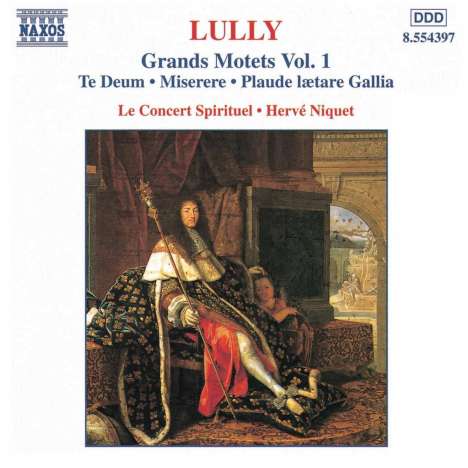Jean-Baptiste Lully: Grosse Motetten Vol.1 auf CD
Grosse Motetten Vol.1
Herkömmliche CD, die mit allen CD-Playern und Computerlaufwerken, aber auch mit den meisten SACD- oder Multiplayern abspielbar ist.
(soweit verfügbar beim Lieferanten)
Te Deum; Miserere; Plaude Laetare Gallia
- Künstler:
- Le Concert Spirituel, Niquet
- Label:
- Naxos
- Aufnahmejahr ca.:
- 1993
- Artikelnummer:
- 1391219
- UPC/EAN:
- 0636943439722
- Erscheinungstermin:
- 19.7.1999
Das Te Deum ist Lullys bekanntestes geistliches Werk, das am 9. September 1677 in Fontainebleau uraufgeführt wurde. Bei einer weiteren Aufführung des Stückes am 8. Januar 1687 fügte sich Lully unter der Leitung von 150 Musikern selbst die Wunde zu, die sich als Wundbrand erwies und sich als tödlich erweisen sollte. Die Ursprünge des Te Deum waren ganz anders als die der anderen Werke auf dieser Aufnahme. Lully war auf dem Höhepunkt seiner Karriere, der immens erfolgreiche Komponist lyrischer Tragödien wie Atys und Isis. Das Te Deum verlangt hohen Einsatz und beträchtliche Ressourcen. Zeitgenössische Berichte sprechen von den großen Ensembles (bis zu 300 Musiker, darunter Chor, Orchester, Trompeten und Trommeln), die bereits zu Beginn des achtzehnten Jahrhunderts zusammenkamen, um das Werk aufzuführen. Der Erfolg des Te Deum ist fast einzigartig in der Geschichte der geistlichen Musik des siebzehnten Jahrhunderts.
Product Information
The Te Deum is Lully's best-known sacred work, first performed at Fontainebleau on 9th September, 1677. It was while directing 150 musicians in another performance of the piece on 8th January, 1687 that Lully inflicted on himself the wound which, turning gangrenous, was to prove fatal. The origins of the Te Deum were quite different to those of the other works on this recording. Lully was at the pinnacle of his career, the immensely successful composer of lyric tragedies like Atys and Isis. The Te Deum calls for high pomp and considerable resources. Contemporary reports speak of the large forces (as many as 300 musicians, including chorus, orchestra, trumpets and drums) assembled to perform the work, even at the beginning of the eighteenth century. The success of the Te Deum is almost unique in the history of seventeenth century sacred music.
Disk 1 von 1 (CD)
-
1 Te Deum: Symphonie
-
2 Te Deum: Patrem immensae majestatis
-
3 Te Deum: Tu ad dexteram Dei sedes
-
4 Te Deum: Salvum fac populum tuum
-
5 Te Deum: Dignare, Domine
-
6 Te Deum: In Te, Domine, speravi
-
7 Miserere: Symphonie
-
8 Miserere: Ut justificeris in sermonibus
-
9 Miserere: Averte faciem tuam
-
10 Miserere: Docebo iniquos vias tuas
-
11 Miserere: Benigne fac, Domine
-
12 Plaude laetere Gallia: Symphonie
-
13 Plaude laetere Gallia: O Jesu vita Precantium
-
14 Plaude laetere Gallia: Vivat regnet princeps fidelis
Mehr von Jean-Baptiste L...
-
Jean-Baptiste LullyThesee3 CDsVorheriger Preis EUR 29,99, reduziert um 0%Aktueller Preis: EUR 14,99
-
Jean-Baptiste LullyPsyche3 CDsAktueller Preis: EUR 14,99
-
Jean-Baptiste LullyL'Idylle sur la paixCDAktueller Preis: EUR 17,99
-
Jean-Baptiste LullyCadmus & Hermione2 CDsAktueller Preis: EUR 29,99






